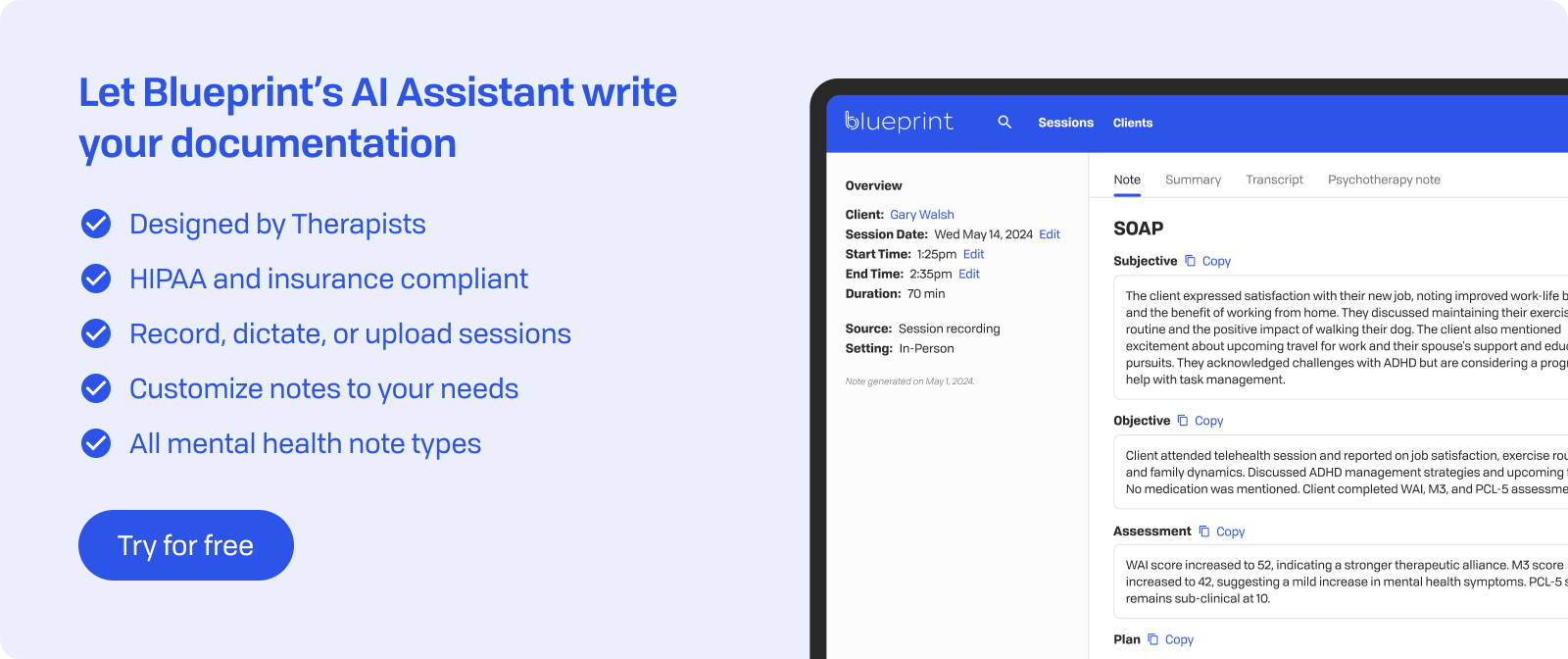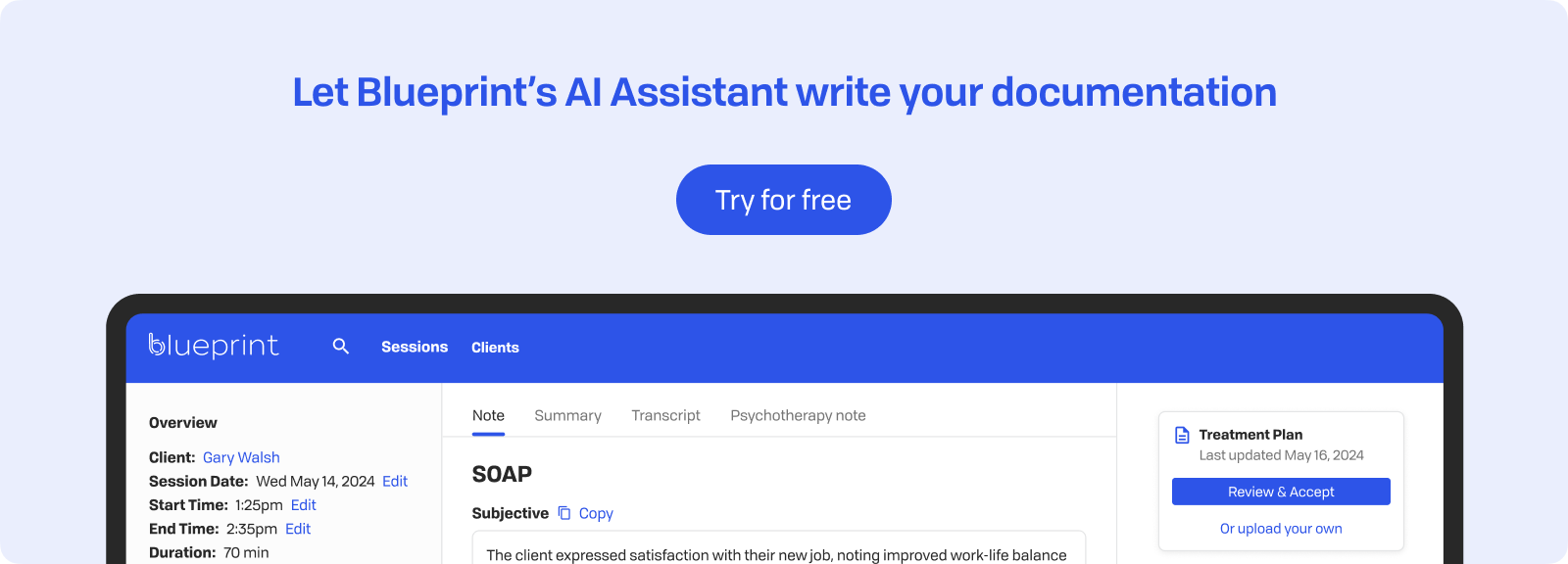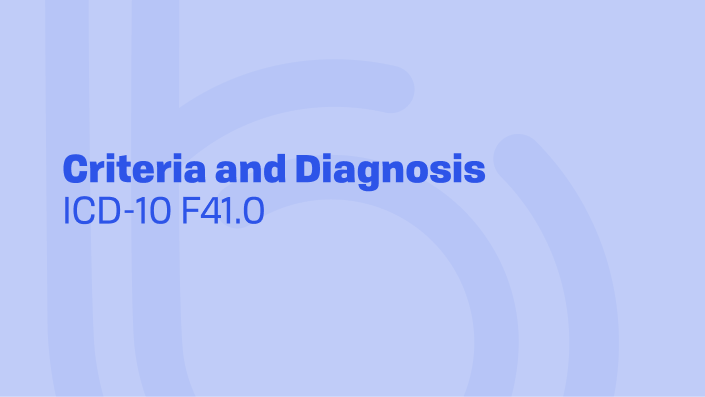In Brief
Panic attacks often hit without warning, leaving clients feeling out of control or fearing for their lives. These intense fear episodes are just one aspect of a complex anxiety disorder affecting millions. Accurate diagnosis plays a key role—not just in planning treatment, but also in helping clients make sense of their experiences.
The journey from identifying symptoms to confirming a diagnosis demands precision and careful attention to diagnostic criteria. Every therapist must understand how panic disorder appears and how to distinguish it from other anxiety conditions. This knowledge is the backbone of effective treatment and precise clinical documentation.
Knowing the ICD-10-CM classification system ensures clear communication in clinical settings. Whether you're interacting with other providers, filing insurance claims, or tracking treatment outcomes, proper coding is important. Let's look into how the ICD-10-CM system addresses panic disorder and what you need to know for your practice.
ICD-10-CM Coding for Panic Disorder
The main ICD-10-CM code for panic disorder is F41.0 – Panic Disorder without agoraphobia [episodic paroxysmal anxiety]. This code identifies the recurrent, unexpected panic attacks that define this condition. When documenting, use F41.0 for clients who experience distinct episodes of intense fear with physical and cognitive symptoms.
Differentiate F41.0 from other anxiety-related codes in the ICD-10-CM system. For example, F41.1 stands for Generalized Anxiety Disorder (GAD), which involves ongoing excessive worry about various aspects of life, often interfering with daily functioning rather than episodic panic attacks. Other related codes include F40.01 for Agoraphobia with panic disorder and F41.8 for other specified anxiety disorders, which is used when anxiety symptoms don't quite fit into the more specific categories. These distinctions ensure accurate diagnosis and suitable treatment planning.
According to ICD-10-CM guidelines, several key diagnostic criteria must be met for F41.0. The client must have recurrent panic attacks not consistently linked to specific situations or objects. These attacks should involve a sudden onset of palpitations, sweating, trembling, or other autonomic symptoms. Additionally, the client must experience at least one month of ongoing concern about having more attacks or significant behavioral changes connected to the attacks.

Diagnostic Criteria and Symptom Presentation
Panic disorder centers on sudden, intense fear with overwhelming physical symptoms. During a panic attack, clients experience at least four symptoms peaking within 10-20 minutes:
- Cardiovascular symptoms: Palpitations, racing heart, or chest pain
- Respiratory symptoms: Shortness of breath, choking sensations
- Neurological symptoms: Dizziness, numbness, tingling, or trembling
- Psychological symptoms: Fear of dying, losing control, or going crazy
- Autonomic symptoms: Sweating, chills, hot flashes, or nausea
- Dissociative symptoms: Feelings of detachment or unreality
For an F41.0 diagnosis, panic attacks must happen repeatedly and without warning. The frequency differs among clients—some experience weekly attacks, while others face clusters followed by months of relief. Between attacks, clients often report ongoing worry about future episodes for at least one month, leading to behavioral changes like avoiding certain places or activities.
Ruling out medical or substance-induced causes is very important. Thyroid conditions, cardiac issues, caffeine intoxication, or withdrawal from substances can mimic panic symptoms. A thorough medical history and collaboration with medical providers ensure accurate diagnosis.
Consider other conditions that often appear alongside panic disorder. About 30-50% of clients with panic disorder also meet criteria for agoraphobia (F40.01). Depression frequently co-occurs, affecting treatment planning and outlook.
Assessment Tools and Evaluation Strategies
Accurate assessment of panic disorder involves combining clinical interviews with validated screening tools. Begin with a structured clinical interview to explore the nature, frequency, and triggers of panic attacks. Key interview techniques include:
- Building rapport first: Create a comfortable environment where clients feel safe discussing their symptoms
- Asking specific symptom questions: Inquire about physical sensations, thoughts during attacks, and behavioral changes
- Exploring timeline and patterns: Document when attacks started, their frequency, and any identifiable patterns
- Assessing functional impact: Understand how panic affects work, relationships, and daily activities
The Severity Measure for Panic Disorder (SMPD) is a valuable, evidence-based tool for quantifying symptom severity, particularly within the DSM-5 framework. This 10-item self-report scale assesses the frequency and impact of panic symptoms over the past seven days. Each item is rated on a 5-point scale (0-4), resulting in a total score that ranges from 0 to 40. Higher scores indicate greater symptom severity. Unlike some older scales that are clinician-administered, the SMPD is designed for clients to complete before or during a clinical visit, providing a quick and objective measure for tracking treatment progress and supporting clinical documentation.
Ruling out differential diagnoses is important for accurate F41.0 coding. Medical conditions that mimic panic include:
- Cardiac issues: Arrhythmias, mitral valve prolapse, or coronary artery disease
- Endocrine disorders: Hyperthyroidism, hypoglycemia, or pheochromocytoma
- Respiratory conditions: Asthma or chronic obstructive pulmonary disease
- Neurological conditions: Temporal lobe epilepsy or vestibular dysfunction
Additionally, differentiate panic disorder from PTSD-related panic attacks, which occur in response to trauma reminders. Consider substance-induced anxiety disorders, particularly with stimulants or withdrawal states. Collaborate with medical providers when physical symptoms dominate the presentation or when clients haven't had recent medical evaluations.

Treatment Planning and Therapeutic Interventions
Successful treatment for panic disorder (F41.0) involves a thorough approach that combines evidence-based psychotherapy with careful monitoring of symptoms. Cognitive behavioral therapy (CBT) stands out as an effective method, with panic-focused CBT protocols that include cognitive restructuring and interoceptive exposure being the most efficacious. Key aspects of CBT include:
- Psychoeducation: Educating clients about the panic cycle and normalizing physical sensations
- Cognitive restructuring: Challenging catastrophic interpretations of bodily sensations
- Interoceptive exposure: Gradually exposing clients to feared physical sensations through exercises like hyperventilation or spinning
- In-vivo exposure: Systematically confronting avoided situations or activities
Some new therapeutic approaches also show promise alongside traditional CBT. For example, panic-focused psychodynamic psychotherapy (PFPP) addresses underlying emotional conflicts, Eye movement desensitization and reprocessing (EMDR) helps process trauma-related panic triggers, and virtual reality exposure therapy provides controlled environments for practicing coping skills.
Medications often work alongside psychotherapy. SSRIs like sertraline or paroxetine are primary options, typically showing effects within 4-6 weeks. Benzodiazepines offer quick relief but carry dependency risks, so they are best for short-term use only. Newer methods include D-cycloserine to enhance CBT and neurosteroid modulators for quick anxiety relief.
Monitoring progress helps guide treatment adjustments. Use standardized measures like the PDSS weekly during active treatment phases. Keep track of panic frequency, anticipatory anxiety levels, and functional improvements. Telehealth platforms facilitate consistent monitoring between sessions, allowing for real-time adjustments to treatment plans. Clearly document symptom changes in progress notes, linking improvements to specific interventions for F41.0 coding accuracy.

ICD-10-CM Coding in Clinical Documentation and Billing
Using F41.0 correctly requires consistency across all documentation points. Include the code in initial treatment plans, progress notes, and insurance claims to maintain clear clinical records. When documenting panic disorder, describe the frequency and severity of attacks, along with any functional impairments that justify ongoing treatment.
Documentation must align with ICD-10-CM standards through precise language that captures the episodic nature of panic attacks. Key elements to include:
- Attack frequency and duration: Document specific numbers (e.g., "3-4 panic attacks weekly, lasting 10-20 minutes")
- Physical symptoms present: List the specific symptoms experienced during attacks
- Behavioral changes: Note avoidance patterns or lifestyle modifications
- Treatment response: Track improvements using measurable outcomes
Common issues can lead to inaccurate coding and reimbursement. Under-specifying comorbid diagnoses is a frequent error—if your client has both panic disorder and major depression, code both F41.0 and the appropriate F32/F33 code. Avoid using unspecified anxiety codes (F41.9) when criteria for F41.0 are clearly met. Another frequent error is misspecifying the relationship between panic disorder and agoraphobia. Instead of coding F41.0 and F40.00 (which implies no history of panic), the correct code for a client with both conditions is F40.01.
Be mindful of these documentation mistakes:
- Using symptom codes instead of disorder codes: Code the established diagnosis, not isolated symptoms
- Missing psychosocial context: Include relevant Z-codes for stressors affecting treatment
- Inconsistent coding across documents: Ensure all paperwork reflects the same diagnostic codes
- Outdated code usage: Stay current with ICD-10-CM updates and revisions
Clear, specific documentation supports both clinical integrity and appropriate reimbursement while ensuring continuity of care across providers.
Ethical and Cultural Considerations in Treating Panic Disorder
Cultural background significantly influences how clients experience and express panic symptoms. What Western diagnostic criteria describe as "hot flashes" might appear as a "sense of heat rising" in the chest among Puerto Rican clients experiencing ataques de nervios. These culture-specific presentations need careful attention to avoid misdiagnosis or missing significant symptoms that don't align with standard F41.0 criteria.
Consider these cultural variations in panic presentation:
- Asian American clients: Often report panic symptoms less frequently, possibly due to collectivistic values that discourage expressing individual distress.
- Cambodian populations: May experience khyâl attacks, involving beliefs about wind and bodily processes causing panic-like symptoms.
- Latino/Hispanic communities: Ataques de nervios can include uncontrollable crying, trembling, or dissociation that differs from typical panic attacks.
Addressing stigma involves providing culturally-informed psychoeducation. Present panic disorder as a medical condition affecting the body's alarm system rather than a personal weakness. Use culturally relevant metaphors and examples that resonate with your client's background. Some cultures view mental health concerns through spiritual or family-centered perspectives, requiring adapted explanations.
Informed consent involves more than standard procedures when working across cultures. Discuss:
- Diagnostic implications: Explain how an F41.0 diagnosis might be understood within their cultural context.
- Treatment approaches: Acknowledge that Western therapy models may conflict with cultural values.
- Confidentiality boundaries: Clarify limits when family involvement is culturally expected.
- Collaborative adaptation: Invite clients to share cultural considerations that might affect treatment.
Document cultural factors influencing symptom presentation and treatment planning to ensure care that respects diverse experiences of panic disorder.

Key Takeaways
Grasping panic disorder ICD-10-CM coding means more than just knowing F41.0—it's about seeing how accurate diagnosis influences every part of client care. The ICD-10-CM classification uses a universal language that ties together assessment, treatment planning, and clinical documentation into one unified system.
Key points to remember about panic disorder and ICD-10-CM:
- F41.0 specificity matters: This code captures episodic paroxysmal anxiety with distinct criteria—recurrent panic attacks, anticipatory anxiety, and behavioral changes lasting at least one month.
- Documentation drives outcomes: Accurate coding ensures proper reimbursement, supports treatment authorization, and maintains clear communication across providers.
- Assessment requires multiple perspectives: Use structured tools like the PDSS alongside clinical interviews and medical rule-outs for a thorough evaluation.
- Cultural competence is necessary: Panic symptoms appear differently across cultures, needing adjusted assessment and treatment methods.
- Treatment tracking needs consistency: Regular monitoring with standardized measures shows progress and justifies continued care.
Accurate ICD-10-CM coding plays many important roles in mental health practice. It helps with proper reimbursement while minimizing claim denials, ensures regulatory compliance, and aids broader research efforts that enhance our understanding of anxiety disorders. Most importantly, precise diagnostic coding supports personalized treatment planning that addresses each client's unique presentation of panic disorder.
Keeping up with ICD-10-CM updates and sharpening your diagnostic skills directly affects client outcomes. Understanding these coding systems pays off through improved clinical accuracy, smoother administrative processes, and ultimately, better care for those dealing with panic disorder.

How Blueprint can help streamline your workflow
Blueprint is a HIPAA-compliant AI Assistant built with therapists, for the way therapists work. Trusted by over 50,000 clinicians, Blueprint automates progress notes, drafts smart treatment plans, and surfaces actionable insights before, during, and after every client session. That means saving about 5-10 hours each week — so you have more time to focus on what matters most to you.
Try your first five sessions of Blueprint for free. No credit card required, with a 60-day money-back guarantee.
























